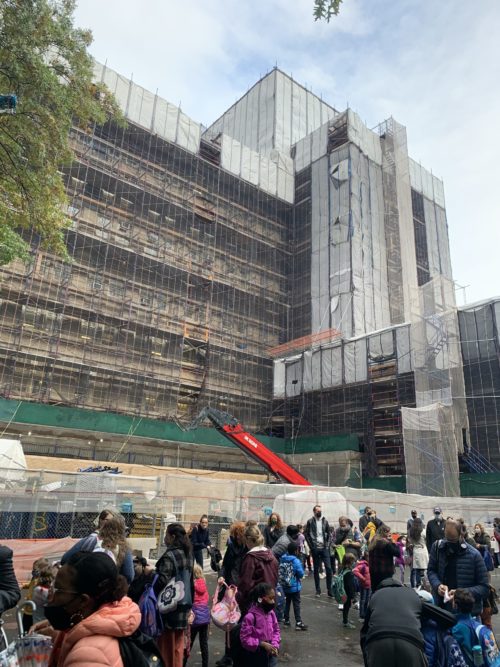
By Ann Cooper
The imposing entrance of the landmarked Joan of Arc Junior High School building on W. 93rd Street first towered over Upper West Side students in the early 1940s. But if you walk down 93rd between Columbus and Amsterdam today, it’s easy to miss that entrance; in fact, you can’t really see any of this massive eight-story building, cloaked as it is in curtains of netting and surrounded by the metal beams and wooden planking that signify another New York City scaffolding project.
For seven years since Joan of Arc was first scaffolded, parents and children have squeezed under the protective “sidewalk sheds,” crowding onto the narrowed walkway or spilling out into 93rd Street to await the start of each school day.
“It’s just a total shitshow in the morning,” says Lynn Feng, whose son attends kindergarten at Manhattan School for Children, one of three schools that share quarters inside. Students have graduated “never having seen the school without scaffolding,” says Gui Stampur, another kindergarten parent, who has worked with Feng on a petition demanding the city “give us back” the school, by speeding up the façade repairs that require the scaffolding remains in place.
The Joan of Arc building is not the city’s longest-running scaffolding saga. It’s not even the longest one on the Upper West Side. But it is a particularly graphic reminder of the omnipresence of scaffolding and its impact on city lives – in this case, on parents, teachers and students whose school’s exterior has the feel of a permanent construction project; on residents in surrounding co-ops, who have lived with years of construction noise that begins after school is out for the day and goes on into nighttime hours; and on the city officials responsible for public safety and community relations.
New York is a city packed with scaffolding and scaffolding stories. But how much do most of us really know about why it’s there, and why it sometimes seems to stay in place permanently? Read on for some answers.
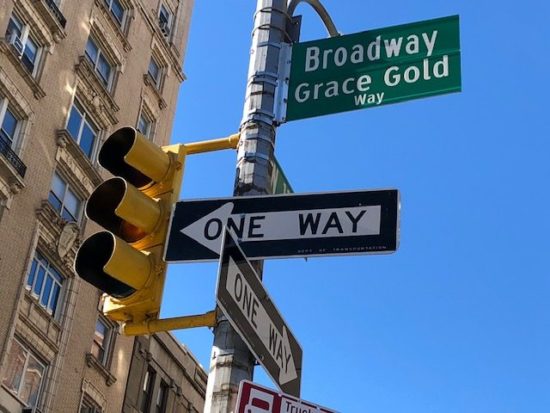
Why is so much of NYC encased in scaffolding?
Some of it surrounds new construction, and some is there to enable emergency repairs, such as roof leaks. The work at Joan of Arc was first announced as a three-year project in 2014 to replace an aging roof. But the scaffolding has stayed in place to bring the building into compliance with city-required façade inspections and repairs.
Those requirements were enacted more than 40 years ago in the wake of an Upper West Side tragedy. On a spring night in 1979, Barnard College freshman Grace Gold was walking by a Columbia University-owned building at 115th Street and Broadway when a chunk of concrete masonry fell from the seventh floor. It struck Gold’s head and killed her.
Within months, city officials responded with a new law requiring safety inspections every five years for all city buildings more than six stories high. The scaffolding and “sidewalk sheds” (the metal beams and wooden planks that form a ceiling over the sidewalk) are there to protect passersby from any falling debris during façade inspection and repairs.
How do the façade inspections work?
Local Law 11, an update of the original inspection law, says a licensed architect or engineer must carry out a building’s inspection and send a report to the city’s Department of Buildings. Any deficiencies found by the inspector (such as cracked bricks or masonry, or loose metal anchors) are supposed to be corrected within 90 days. But the law allows for multiple time extensions.
How much of the city scaffolding I see is there because of Local Law 11?
First, a word about “scaffolding.” Many people use the term to refer to any and all of the structure around a building or construction site. But the part most likely to cause complaints is what you see at ground level: the sidewalk shed. It’s the metal and wood structure that protects pedestrians – but also narrows the walkway, creates an eyesore, can collect trash around its supporting poles, and in some places has become an open-air home for the homeless.
So how much is there because of Local Law 11? You can calculate that on a Department of Buildings map, updated daily, that shows where permits have been granted for sidewalk sheds. On February 8, the map showed permits had been authorized for 310 sidewalk sheds, stretching 180 miles, for Local Law 11 compliance. Another 242 sheds, covering 167 miles, were authorized for sites involving new construction or emergency repairs. Total sheds in the city: 552, covering 347 miles of sidewalk. The map also showed that sheds in place for Local Law 11 compliance had been up for 310 days, on average; the figure for new construction and repairs was 242 days.
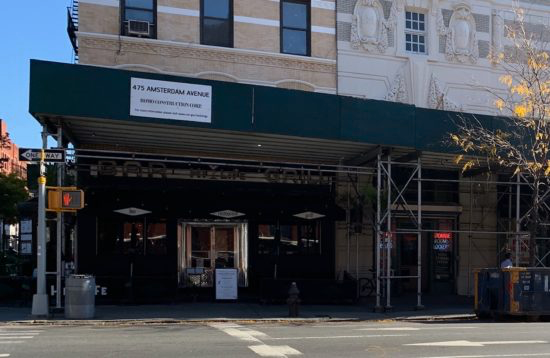
It seems like some scaffolding is permanent. Aren’t there limits on Local Law 11’s time extensions?
Though the law gives a timetable for making repairs, the bottom line is safety. So if damage hasn’t been fixed within the law’s timeframe, the city permits sidewalk sheds to remain in place – sometimes for years.
Media stories occasionally highlight particularly long-running cases: a 10-year-old sidewalk shed outside a Harlem deli, a 15-year-old shelter at a Harlem condo, the perennial Upper West Side shed that hides the entrance to Hi-Life Bar & Grill at Amsterdam Avenue and 83rd Street.
That Amsterdam Avenue shed had been standing for 6 ½ years when West Side Rag wrote about it in 2019. More than two years later, the shed and Hi-Life are still there. But Metropolitan Window Fashions, another retailer whose entrance was obscured by the shed, is now replaced by an art gallery that invites visitors by appointment only.
Metropolitan’s owner Bruce Heyman told West Side Rag that the sidewalk shed was “a big factor,” though not the only reason, why he sold the business in 2020. Heyman estimates that by obscuring his entrance, the shed reduced his business by 20 percent. The city should be setting clear time limits for owner repairs and then “fining them up the wazoo” if they exceed them, says Heyman. “You’ve got to enforce the rules.”
Can the city fine building owners for not making repairs?
Yes, but for years critics have argued that the fines were far too low to have an impact and that even when penalties are levied the city has trouble collecting them.
At a 2017 city council committee hearing, city officials acknowledged what many have said for years: that it could be cheaper for a building owner to pay fines and keep sidewalk sheds in place (to protect pedestrians from falling masonry) than to actually repair the faulty masonry. Cost of an average façade repair job, said a Department of Buildings official, could be $300,000. Cost of fines if the owner failed to request a permit extension for its sidewalk shed: $1,000 a month.
A tragic example of ineffective fines came in 2019 at a building near Times Square, where a damaged façade presented “a falling hazard for pedestrians,” according to a city buildings inspection. The city levied a $1,250 fine and ordered the owner to install a sidewalk shed. But that was never done, and several months later a woman was killed when a chunk of the unrepaired façade fell on her.
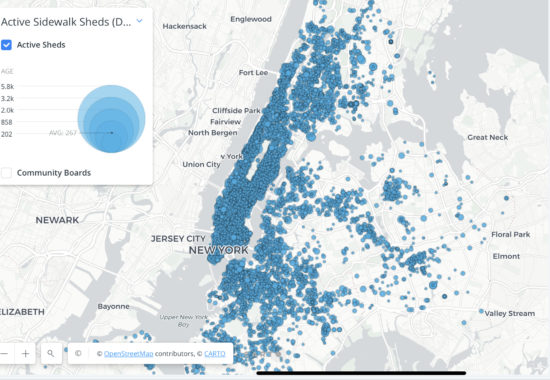
Did the Department of Buildings increase its fines after that?
According to a DOB spokesman, the agency approved “a substantial increase” in penalties in January 2020. The fines are calculated on the length and age of the sidewalk shed. As an example, DOB said if penalties were called for at 475 Amsterdam (the shed that covers the front of Hi-Life Bar & Grill), they would total $5,720 a month, or $68,640 a year.
Though the department used 475 Amsterdam as an example, spokesman Andrew Rudansky said no new penalties are being calculated right now for the owners of Sofia Storage, which is responsible for the shed at that address, because they “are currently making progress on repairs” and expect to complete them this spring. “If the Department was to determine that the owners were no longer taking those steps” Rudansky said by email, penalties would be levied – adding on to $18,750 in unpaid fines DOB has already imposed on 475 Amsterdam.
The DOB’s public database shows that two of the outstanding fines were issued eight years ago, in 2013, and a third one in 2017.
What’s happened to attempts to get scaffolding taken down more quickly?
The main legislative attempt was a bill first introduced by then-District 5 City Council member Benjamin Kallos in 2016. The Kallos proposal would have given owners six months to finish repairs required by Local Law 11. After that, if a building façade still hadn’t been repaired, city employees would do the work and send the owner a bill. And the scaffolding would come down.
Soon after Kallos introduced his bill, the city unveiled its online map showing just how much scaffolding is out there and how long it’s stayed up. The New York Times editorial board hailed the map for revealing that sidewalk sheds can be “as durable and mysterious as the monoliths of Stonehenge.” It seemed like the map might give a boost to the Kallos proposal.
The bill did get a hearing in a city council committee, where restaurant and retail owners enthusiastically endorsed it, while the Real Estate Board of New York was opposed. The Department of Buildings testified that the city did not have the resources to step in and do repairs if owners didn’t make the deadline.
The bill never came up for a vote, though Kallos continued to speak out, labeling sidewalk sheds “the house guest that never leaves” and noting that some scaffolding “is almost old enough to vote.” His sound bites gained media attention but failed to build enough support among council colleagues. Kallos blames the real estate industry’s opposition for the death of his bill; Crain’s New York Business reported that it didn’t help when Kallos lost some clout in internal council politics, endangering the scaffolding bill that he had made a top priority.
Kallos was term limited out of his council seat and lost a bid for Manhattan Borough President last year. In a recent interview he told West Side Rag that he was not aware of any current council members planning to reintroduce his bill. As long as the city continues to allow unlimited time extensions, “no one’s forcing [building owners] to make the repairs,” he said.
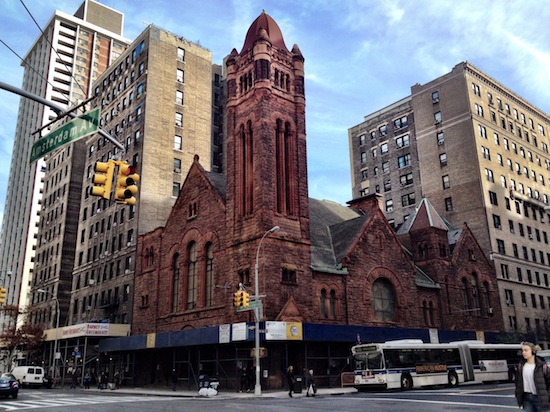
Would the Kallos bill have solved the problem of long-term scaffolding?
The bill’s hard, six-month deadline for repairs had some real appeal for those frustrated by scaffolding projects that never seem to come down.
But the one-size-fits-all deadline didn’t leave room for any extenuating circumstances. Delays can come for a variety of reasons, such as weather, supply chain issues, or difficulty finding materials to match the façade of the city’s many landmarked buildings.
For some buildings, the issue is lack of funds. When West Side Rag wrote about West Park Presbyterian Church at 86th and Amsterdam, for example, it had been fronted by a sidewalk shed for 18 years, because the church’s dwindling congregation couldn’t afford pricey repairs on the landmarked, late-1800s red sandstone building.
Three years later, a shed still protects the sidewalk outside the church and looks likely to be there for some time. The Center at West Park, a nonprofit that promotes performing arts, is the church’s main tenant now; center artistic director Zachary Tomlinson said his group is working on a capital campaign for “a multi-million dollar job, for which we do not currently have the funds” to repair the building. Tomlinson described the campaign as “in the beginning phases.”
Would Gale Brewer take up the scaffolding issue, now that she’s representing the Upper West Side again on the city council?
Brewer is chair of the council’s committee on oversight and investigations, which gives her authority to look into a wide variety of issues. Scaffolding delays “is on my list,” she said in an interview with West Side Rag – before adding that the list is five pages long, and everything on it is considered “top priority.”
Brewer said any solution needs to make allowances for legitimate circumstances that make a job longer. At the same time, “there have to be more sticks” to force recalcitrant owners to get repairs finished. But she questioned the Kallos bill’s approach of sending the city to make repairs if a building doesn’t meet deadline. “What happens if the city doesn’t do it?” she said. “Then what? You don’t really sue the city and get anywhere, to be honest.”
The bottom line question that remains unanswered: “How do you get [façade repairs] moving, at the same time make sure that no brick falls and kills somebody?”
If the City Council doesn’t act, is there anything else that can be done?
City officials recommend phoning in scaffolding complaints to the city’s 311 service; some who’ve tried don’t report much success.
Parents of children in the schools at Joan of Arc launched a petition, which now has more than 500 signatures, demanding a speedup of the façade work. They want to see the scaffolding and sidewalk shed removed before a new school year starts next fall.
Their demands have gotten some media and official attention, including an early February Zoom meeting with officials of the School Construction Authority (SCA), which is responsible for capital repairs at city schools.
The authority’s explanations for delays – the pandemic, weather, supply chain issues, the replacement of an unsatisfactory contractor with a new one – did little to win over the handful of parents and residents on the call. Some had hoped that adding regular weekend work to the schedule would mean the job could be finished and scaffolding removed by end of summer. SCA officials confirmed that work would go forward on Saturdays, starting this month, but they said the project still won’t be finished until later this year. Some parents were skeptical that even that deadline would be met.
“I do understand the frustration,” SCA project officer Edward Kelly told the Zoom participants, more than once, as he offered a variety of conciliatory messages. The meeting ended with a new promise – not for a revised deadline, but for a continuation of community meetings with SCA, as long as it takes, until Joan of Arc is repaired and the UWS landmark can be unveiled.






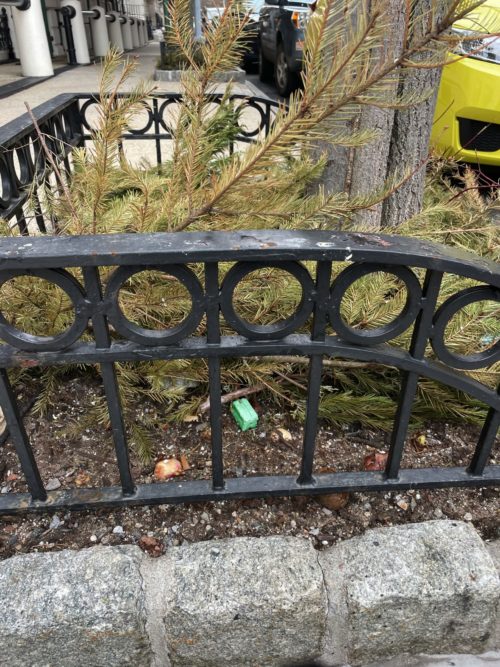


That school has scaffolding not because it’s generally falling apart but because the School Construction Authority has botched the exterior masonry renovation job up and down. They say they had contractor problems, which is possible, but they’re a state authority, they can hire almost any contractor they want. They don’t have to go with the lowest bidder system that very often forces City agencies into using the lowest bidder contractor. If the job had been done properly the scaffolding would have come down years ago.
So, it could take an owner 10 or 15 years to come up with $300,000?
The scaffolding has been up on the PS 165/Mott Hall II building for over ten years. They are replacing the roof— very, very slowly. Keep in mind that the entire Empire State Building went up in a couple of years. Allegedly it will be done over the summer, fingers crossed.
Everybody has their own scaffold nightmare. We have scaffolding next door that has been up for five years, child’s play compared to others.
Worst offender is on 73rd St between CPW and Columbus, closer to Columbus. It’s a brownstone and the people have owned it since the 70s. They refuse to sell or do anything with it. It sits vacant. Not sure how long ago, maybe 8(?) yrs ago scaffolding was erected as it was falling apart. The brownstone next to it has a sweet bay-window that is blocked by netting blocking their view of Columbus and also makes their apartment darker. Sadly, there is no chance that scaffolding is ever coming down. None. City is powerless. I use this case as a bench mark. If the city can’t do anything about this property, I don’t have much trust they can resolve other issues.
This Feb 15th at 3:19am a concrete block was thrown thru my front parlor window. The hoods who did it stood on a scaffolding pipe–right in front of my window–from the abandoned building next door-44 West 73rd Street. This scaffolding has been up forever and no one does anything about it. Now it has led to a crime. My crime.
Always wondered what the deal was with that brownstone on 73rd. Feel bad for the neighbors, what a shame.
Thanks for your reporting!
What about the incompetence and delays of the Department of Buildings? I know of a LL11 project that has had a stop work order for several months because an inspector didn’t like something that a previous inspector had said was fine. This pushed the project into the winter months and caused a dispute with a neighbor who does not want a (now required by the city) sidewalk shed in front of their building. Making the building department accountable for issues that they cause—such as delays or requirements that seem to change at the whim of an individual inspector—would go a long way.
Great article, though would have appreciated a slightly more critical look at the Landmark district extensions from around 2013.
Pushed by Landmarks West, these landmark district extensions introduced significant costs and delays maintaining facades. The expansion of these districts in 2013 cost my prior building around $500,000 extra for facade maintenance because we were forced to extensively replace and color-match dozens of terra cotta windowsills. And they weren’t even particularly sculpted terra cotta. Just a lot of mostly-rectangular blocks that had to be sampled, sent for color-matching, approved by the city and then handcrafted and installed by hand (with new brickwork around the sills.
Yes, I know it’s probably pretty. But in a city with affordability issues do we really want to force people to spend the time and money on this stuff? Plain stone sills would be just as good.
We can talk all day about scaffold laws, but the scaffolds are up longer because over the past ten years our politicians have made repairing facades take longer (and cost much more money) with nary a debate about the tradeoffs.
Agree: This is a very important point about landmarks. They take weeks/months to grant/deny approval of seemingly trivial items, such as grout color. They can be capricious and entirely insensitive to costs and time. This adds months to LL11 projects, not to mention the cost. The medicine that the landmarks commission provides is worse than the disease. Penn Station will never again be a beaux arts masterpiece. Let the market decide what is a landmark. If you want to keep a building as it has ever been…. then go ahead and buy it!
It took 14 months to build the Empire State Building.
17 Months to build the Alaska Highway.
Actually, it only took 11 months to have the ESB ready for its first tenants; the other three months were simply final touches. I know because I worked for (not just in) the building, and know more about its history than most. But it is also worth noting that, due to the lack of labor laws and other regs, construction was done almost 24/7, and several workers died during its construction.
It is estimated that, were the ESB to be built today – with current fire and safety codes and construction regs – it would take ~3 years.
I had no idea it took only 13 months to build the ESB. Thanks for that bit of info! The ‘new’ condo going up on my block has taken 3 years and there appears to be no end in site. 🙁
What about a law that converts the daily fines into liens against the property? Then, the longer the owner keeps the scaffolding up, the owner’s equity stake in the building is reduced. Complex subject but do something!!!
That’s already the case. Properties don’t transfer without paying off the fines.
Great, so why not have a date (say 3 years) at which point the ownership of the building transfers to the city? We could gain a lot of affordable housing that way 🙂 and yes this is a serious suggestion.
This article is a tremendous public service. I hope a copy will be sent to every City Council member starting with Speaker Adams and Gail Brewer, a copy placed on the desk of every reporter in Room 9, and that rallies will be organized on the steps of City Hall. The mayor should be asked about this at every press conference. THERE IS NO OTHER CITY IN THE COUNTRY IN THIS SITUATION. Our politicians created this problem and it’s up to us to convince them to fix it.
No other city in the whole world like this!
A total disgrace that’s been going on for decades.
As far as I can tell, the city still owns the Regent, a supportive housing development on 104th and Broadway. Their scaffolding has been up for years.
Putting aside the many problems with “work in progress that isn’t progressing” – which is a separate issue, maybe we just don’t need a law that requires scaffolds every five years?
Excellent article – thank you for reporting! And thank you for including the DOB map showing the length of time sheds have been up. It should be noted, however, that this map is not fully accurate. I noticed a few sheds that have been up way longer than what is shown on the map (for instance the shed at 350 CPW, between 94th and 95th Streets, has been up for many many years – not 48 days).
I concur. A nearby building in the NYC chart is shown to have a permit date of 10/21. To my knowledge, the scaffolding has been there at least 5 years with little to no work ongoing. I wonder if the NYC DOB chart shows only the latest permit so it is not possible to know the true length of time the scaffolding has been there.
Relevant questions that ought to be asked, I think:
1) How do other cities do this? I have never seen another city so crushed by this blight, even comparably old, vertical cities. They also don’t seem to have problems with falling masonry that are any different than ours. Is our inspection regime too burdensome, giving people incentives to dodge it (leading to tragedy), and honest landlords buried in costs they’d not face elsewhere?
2) Can inspections be done differently, like visual inspections from neighboring buildings or drones, like I know some other cities do do.
3) What incentives lead to such perverse outcomes and can they be changed? Scaffolds are an awful blight and can be menacing; that has a real cost to people and businesses.
This feels like we had a rushed response to past masonry tragedies that went way past a rational point but now can’t be amended given the vested interests and the superficial concept of safety, without that concept *really* being assessed for how to best protect.
Sheds might be a “safety” feature for falling debris, but they are not a safety factor for mugging, extensive garbage, homelessness and neighborhood atmosphere. The law should be enforced so they serve the designated function and removed promptly thereafter. Heavy fines promptly levied would help. Nothing really has been done so far.
Fine all buildings with scaffolding up for more than six months. Fine them every day.
There is also the culpability of building Board members. It is incumbent on the Board to manage any LL11 (and other) projects in an expeditious manner. Many buildings do not which results in scaffolding being up much longer than necessary.
Managing the project involves ensuring the funds are available, picking the right contractors and proactively managing progress.
I’m glad the Rag is looking into this. What about the scaffolding at 104th and Broadway? That has been there forever. Typical of landlords to pay the fines as just another cost of doing business rather than fixing the problem.
Thank you for this excellent article. Very informative and well-written. I also appreciate the tone of it, concerned but not hysterical.
It’s not just that these sheds don’t come down, it’s also that there doesn’t seem to be any coordination between addresses–every building on a block can choose to put up a shed at the same time, it seems. Thus, the beauty of Riverside Drive, the loveliest avenue in the city and my favorite walk, has been ruined for almost its entire length, at least for the time being.
There is a lot I don’t understand about the NYC DOB map of sidewalk sheds. The article says the shed around the West Park Presbyterian Church has been there for 18 years; but the DOB map says it’s been there just 100 days. The shed at 475 Amsterdam, according to the article, has been up for 10 years; the maps says 358 days. In the comments, Big Earl says there’s been a shed around 15 West 73rd for about 8 years; the shed doesn’t appear on the DOB map at all. What accounts for these discrepancies?
Thank you for this very thorough, well-reported article. This is an issue of interest to all of us. There is no excuse for some of these buildings that are constantly under scaffolding, especially schools.
Though doormen love scaffolding as it gives them the winter off from shoveling!
I’ve visited many large cities on every continent and have never seen a great deal,of scaffolding. These include cities much older than New York, where repairs certainly are necessary. Does that mean people in these cities are often killed by falling bricks? Doubt it.
And on a related topic, why do I hear sirens constantly in NYC but not other large cities? Surely in Bangkok, Singapore, Casablanca, and Berlin people are rushed to the hospital and there are fires. Why no sirens?
They need a dedicated scaffolding compliance team..a director,full staff, inspectors and a plan that includes strict time frame limits and harsh penalties where cost is not tricled down to the tenant/state or neighbors..it should come out of the landloard’s pocket directly.
This is why the Rag is such a great addition to UWS life. We count on your for this kind of excellent and thorough reporting on issues that are so relevant to our lives here in the neighborhood.
Many, many thanks.
Nice piece, good to see well-researched fact-based journalism on a topic of importance.
An excellent article, with lots of information and no bias. One thing I wonder about is how lucrative LL11 is to the companies that erect the scaffolding and the sheds and do the waterproofing. Are these companies exerting political influence on the Coty Council not to kill the goose that has been laying golden eggs for them? Is LL11 overkill?
Terrific piece of reporting, WSR! Great journalism always inspires reconsideration of existing policy. I hope this does that!
The most recent scaffolding surrounding 666 WEA (& West 92nd Street) — The Windermere — has been up since April 2021 & no work has been done on the building’s exterior. 666 West End Ave. previously had scaffolding in place from 2008 through 2015! I know this because I live in the building next door & 666’s scaffolding blocked my windows for seven years. We are now six months into their most recent endless construction project. Hey NYC politicians & City Agencies: this is CNN outrageous. Do something about irresponsible building owners & their hideous scaffoldings!
Typo – CNN
Thanks for the article, WSR. The city council’s failure to address this issue, or even acknowledge its urgency, is a great example of public officials who’ve forgotten why they were elected. It’s a massive quality of life problem.
One thing I wonder is whether LL 11 is too strictly enforced, such that buildings with extremely minor façade issues and no realistic safety hazards are required to undergo repairs. Maybe not, but it might deserve a look, along with far steeper penalties for scofflaw property owners.
The problem begins with the law itself, which was a gross over-reaction to a single accidental death. Emotions overcame common sense. Unless the Mayor and City Council are willing to take a hard look at the law and its costs and benefits over all these years to come up with a revised law, all these problems will persist.
Very appreciative of this excellent reporting. Seems to me the primary issue is the continuing power of the real estate industry in our city. Additionally, it seems quality of life in neighborhoods is totally ignored by city officials. Priorities are ALWAYS making money for the city. Meanwhile, big corporations get tax breaks. So sick of rampant capitalism, even in our great town where we should do better.
Not to minimize any of the other problems reported here — and I completely agree with the criticisms widely voiced — but is it really necessary to describe a bad situation as a “shitshow”?
Is that really how the mother of a kindergartner is raising her child to speak?
Or have we completely lost the ability to convey ideas without using four-letter trash talk?
Has anyone done a cost-benefit analysis?
Since NYC is seemingly the only city in the world with the scaffold requirement, it doesn’t seem like many lives are being saved.
It’s not good to lose any lives. But scaffolding is a billion dollar industry. If we save one hundred lives per year, that is $10 million per life. But if we took the billion dollars – or just a fraction of it – and used it for other social programs, we could surely save exponentially more.
I was about to write a similar comment.
It seems to be all to common: something bad happens. A law is quickly passed without thinking much about side-effects or cost.
We see the same thing happening with the new requirements for gas line inspections.
On the other hand the city is very slow approving cost saving measures like using drones for facade inspections.
I would not think of making and accusations, BUT, money talks.
I can see PS 163 from my 9th floor apartment on 97th St. The things that has always bothered me the scaffolding is that it is lit up like a Christmas tree every night, all night! Why is that necessary?
Great article about a subject everyone walking the streets of NYC wonders about, but never had the answers!
Shared on LinkedIn here, https://www.linkedin.com/posts/titleinsurancenewyork_scaffolding-construction-development-activity-6901134067065081856-RxMX
Thank you for an excellent article. I’m writing to emphasize that gross inefficiency by repair & building crews exacerbates the problem. We live right next to Joan of Arc, and we see it. The night crews are too small, so everything takes forever. Meanwhile the noise roars on… We can’t sleep. We have chronic sleep-deprivation and stress-related health issues. We run the A/C constantly in summer because we can’t open the windows due to noise. And the years drag on. Maybe the city would gather the funds for stepping in, if people could sue for pain & suffering!
If I may, here’s one more interesting case. Columbia’s Northwest Corner Building, at Broadway and 120th, which opened in 2010, was designed by an architect from sunny Spain who apparently didn’t know about things like New York winters. So every November through March an ugly green construction shed goes up around the shiny new object, I’m told to prevent ice from slipping down the designer slats that are its hallmark and injuring passersby on the street. Columbia has heaps and heaps of money, and lots of smart people; how are they allowed to continue this apparently ad infinitum?
Scaffolding that goes up and never comes down. That should be the slogan for the City. It’s hard to walk more than a block w/o having to walk under the stinking scaffolding. I think that the scaffolding up at Carmines and that block has been up for 15 years. I’ve tried 311– what a joke. And it’s not just the UWS. This is a pervasive, quality of life issue where garbage & rats collect and the darkness makes it unsafe.